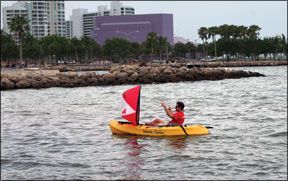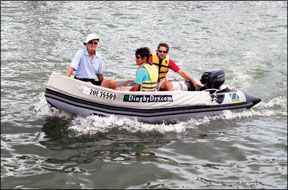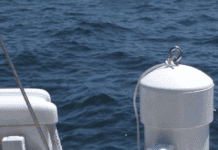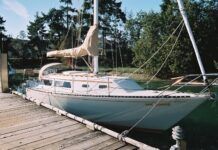Tenders come in all shapes and sizes-from 6-foot inflatable kayaks to RIBs capable of towing skiers-and they serve a variety of transportation needs. Where the live-aboard couple will need a dinghy suitable for grocery and laundry runs, the small-boat daysailor usually needs only a fuss-free, easy ride to a moored or anchored boat. A few accessories that we checked out recently can add to such tender experiences.

WindPaddle Adventure
Adding a sailing rig to a rowing dinghy is far from a new concept, but adding the WindPaddle sail to a kayak, canoe, or other small tender is about as easy a retrofit as there is. The spinnaker-weight circular sail doesn’t require a mast or boom and attaches to the boats existing hardware via small plastic clips.
While its a bit more high-tech than say, using an umbrella downwind as many kayakers do, the WindPaddle is simple and easy to handle. Its self-launching, and to douse it, all you have to do is let it fall forward. The sail-which holds it bowl-like shape thanks to a batten on the sail perimeter-folds up for storage with a bend and twist movement. This was hard to actuate at first, but after doing it several times, testers got the hang of it. The 42-inch-wide Adventure sail has 9.62 square feet of sail area and folds down to 15 inches.
On test sails, the WindPaddle offered decent performance for a light-wind sail, with close reaching and downwind being pretty much the only points of sail. Downwind, the ride was steady and brisk in 8 to 10 knots of breeze.
The WindPaddle comes in two sizes ($175/ Adventure, $225/ Cruiser for heavier boats) and many colors. For sailors who also are avid kayakers, paddle boarders, or canoers, the sail is a good addition to the toy box and can double as working sail for the tender.
The Dinghy Dry

One of the most obvious ways to spot a fellow cruiser in a crowd is by his wet rear-end or “dinghy bottom.” PS Reader Mike Zagrodney, prompted by complaints from his soggy-bottomed crew, designed the Dinghy Dry deflector/splash guard. The Dinghy Dry is a 10-inch-high foam bulwark encased in a Sunbrella sleeve that zips onto the tubes of any inflatable dinghy.
We tested the Dinghy Dry aboard a 10-foot Zodiac Yachtline that serves as tender to Zagrodneys Pearson 424, Second Wind (homeport Palmetto, Fla.). Conditions were a light to moderate chop and about 12 knots of breeze on Sarasota Bay. The shield clearly deflected low waves that would have rolled aboard. At high speeds, it didnt see much spray, but it directed several potential laundry-spoilers while traveling at low speeds in rough water.
Installing the Dinghy Dry requires gluing a zipper to the outside of the dinghy. In his how-to video, Zagrodney uses the all-purpose elastic adhesive Goop to bond the zipper in place. We inspected an installed zipper that had gone through a season of use, and it appeared well bonded, which we found surprising since PVC fabrics are typically harder than Hypalon to glue. Zagrodney reported that he had only some minor touch-up spots to re-glue after stowing the boat last season.
The well-made Dinghy Dry works as advertised, but we have a few concerns. Rolling up and stowing a deflated dinghy is bound to test any glue joint, so we would not recommend this product for someone who regularly stows his dinghy deflated. If you cruise or liveaboard and have a long water commute to the laundromat, work or the grocery, the Dinghy Dry will take some stress out of the ride and may be worth the $375 pricetag.






































